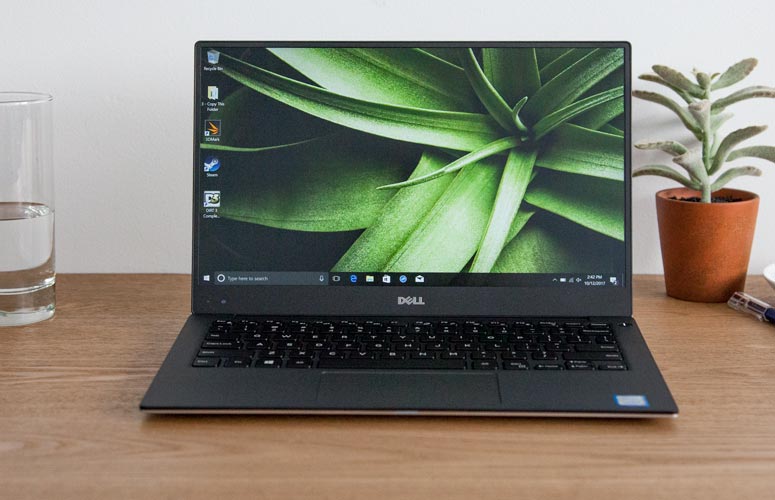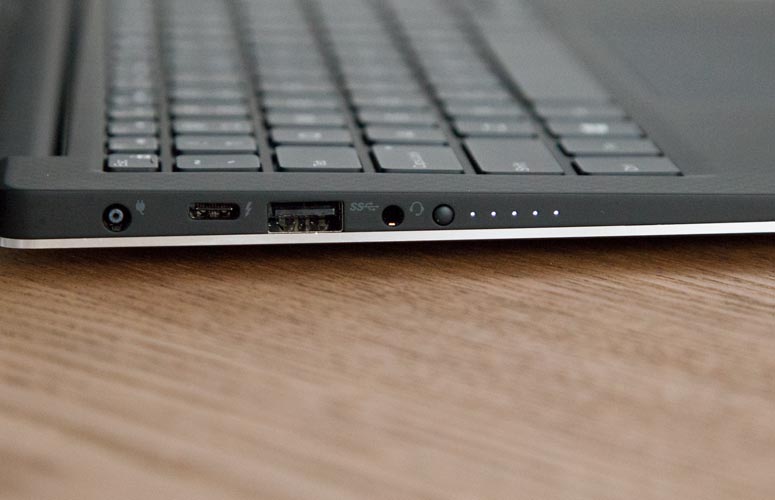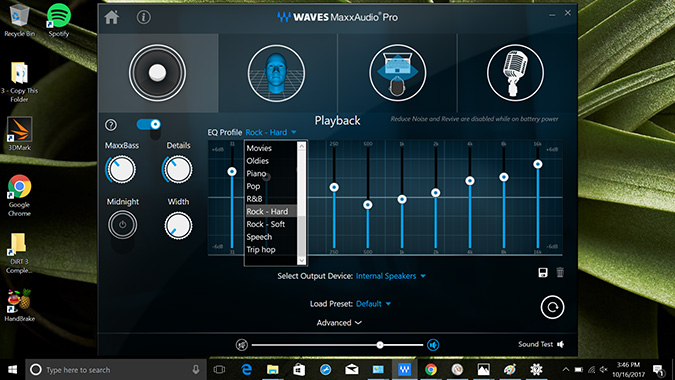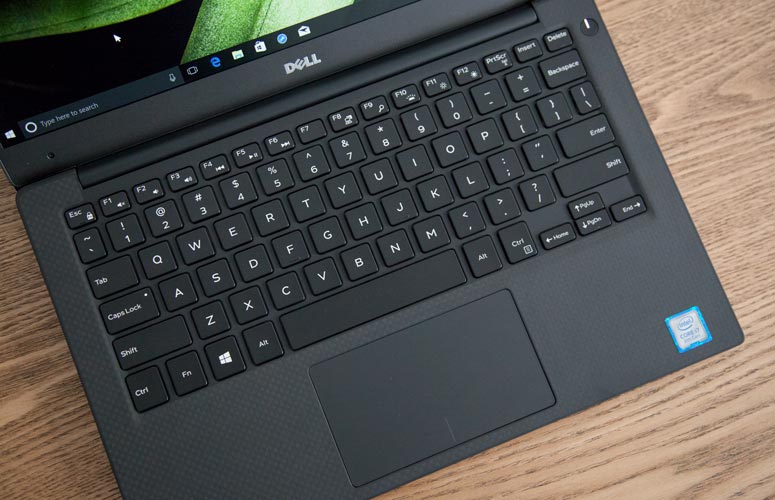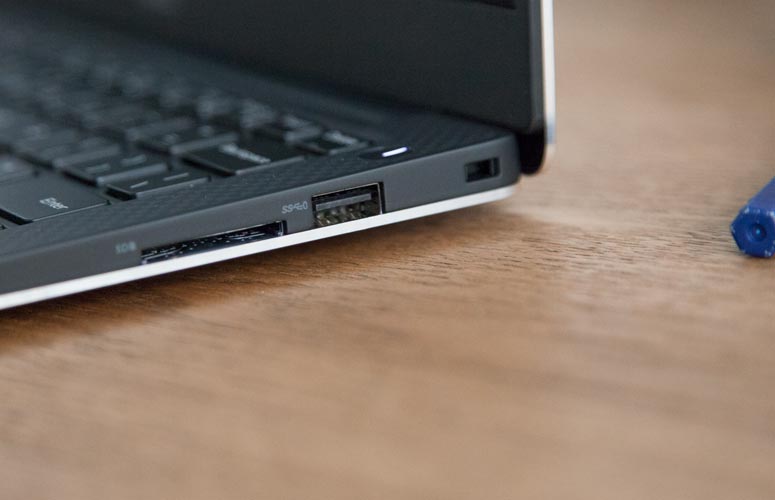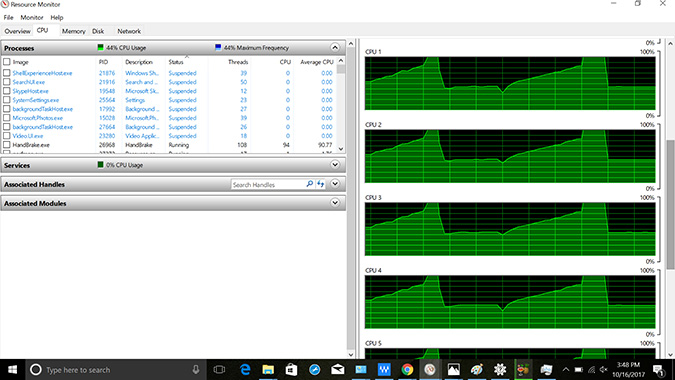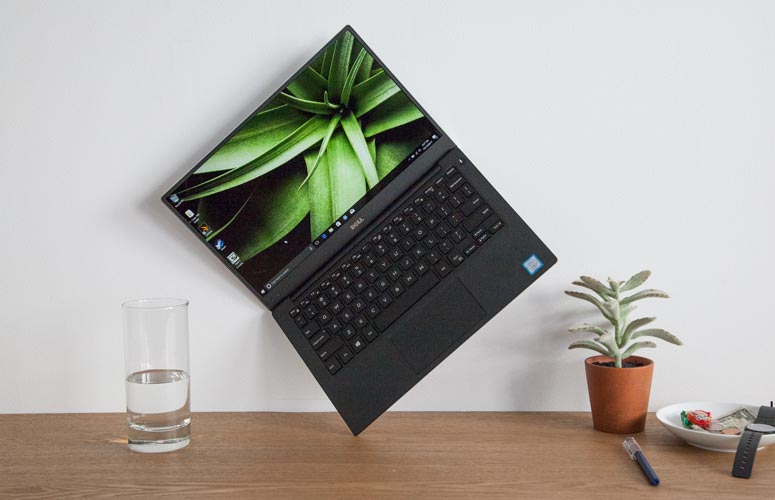Laptop Mag Verdict
The Dell XPS 13 remains our favorite consumer laptop, thanks to its epic battery life, strong 8th Gen Core performance and attractive design.
Pros
- +
Blazing quad-core speed
- +
Epic battery life
- +
Extremely light
- +
Attractive design
- +
Wide viewing angles
Cons
- -
Webcam looks up your nose
Why you can trust Laptop Mag
Dell's XPS 13 has been our favorite laptop overall for the past couple of years, thanks to its light weight, long battery life, beautiful InfinityEdge screen and premium design. To keep up with the times, Dell has upgraded its 13-inch flagship with Intel's new 8th Gen Core (aka Kaby Lake R), quad-core processor platform. Though the new, $1,299 model is otherwise no different from the 7th Gen-powered XPS 13 that Dell continues to sell, it offers much stronger performance and longer battery life while maintaining all the features that make this the best consumer laptop you can buy.
Design
Dell hasn't changed the design on the XPS 13 in a few years, but there's a lot to like about the aesthetic. The lid and bottom surface of the laptop are made from CNC machined aluminum that's either silver or rose gold, depending on which color you choose.
The sides, back hinge and deck are made from a luxurious, soft-touch carbon fiber. I particularly like the deck, which has a subtle crosshatch pattern and a palm rest that's one of the softest and most comfortable I have ever used.
The screen uses Dell's famous InfinityEdge display, which has almost no bezel at all on the sides and top but places the webcam below the screen. The hinge that moves the lid is one of the strongest and tightest I've ever seen, which gives the laptop a high-quality feel but also requires two hands to open.
At 2.78 pounds and 11.98 x 7.88 x 0.6 inches, the XPS 13 is remarkably light and compact. Competitors such as Apple's 12-inch MacBook (2.03 pounds, 0.52 inches thick) and Asus' ZenBook 3 Deluxe (2 pounds, 0.47 inches thick) are even svelter, but both have smaller screens and fewer ports. Lenovo's ThinkPad X1 Carbon (2.49 pounds, 0.6 inches thick) has a larger footprint to accommodate its 14-inch screen, but it, too, weighs less than the XPS 13.
Ports
Sign up to receive The Snapshot, a free special dispatch from Laptop Mag, in your inbox.
Unlike competitors that prioritize thinness over functionality, Dell outfits its lightweight laptop with a full array of useful ports. On the right side, you'll find a USB 3.0 port, an SD card reader and a Noble lock slot. A Thunderbolt 3 port, a second USB 3.0 port, a proprietary charging connector and a 3.5mm audio jack live on the left side. Next to the audio jack, there's a battery meter button and five lights that can show you how much juice you have, even when the system is off.
The Thunderbolt 3 port is particularly helpful, because it allows you to charge the laptop, output to multiple monitors and connect to high-speed USB-C and Thunderbolt peripherals over a single wire.
The XPS 13's 1080p, nontouch screen offers rich, detailed images and extremely wide viewing angles.
Unfortunately, the XPS 13's Thunderbolt port supports only two PCI Express lanes rather than the four you get on other laptops, so Dell's system doesn't support eGPUs. (You can use some of them after bypassing a warning, but they run at lower speeds.)
Display
The XPS 13's base-level 1080p, nontouch screen offers richly colored, detailed images and extremely wide viewing angles. When I watched a trailer for Thor: Ragnarok, shades like the purple in a statue and the mint green in Thor's armor really stood out. The matte surface of the panel made fine details, such as Bruce Banner's stubble,really sharp. Having almost no bezel on the sides and top of the screen also helps improve the experience.
Because the panel doesn't reflect a lot of ambient light and the screen is so bright, viewing angles were some of the strongest I've seen. Colors didn't fade at all from 90 degrees to the left or right, and they even stayed true when I moved the lid forward a bit. So, if you're using the XPS 13 on an airplane tray and the person in front of you leans back, forcing you to lower your screen, you can still watch a movie.
This laptop lasted an epic 16 hours and 5 minutes on the Laptop Mag Battery Test, which involves continuous web surfing over Wi-Fi.
According to our colorimeter, the XPS 13 can reproduce a vibrant 112 percent of the sRGB color gamut, which is more than the category average (101 percent), as well as what we saw from the Lenovo X1 Carbon (104 percent) and the 7th Gen XPS 13 we tested last year (94 percent). The MacBook (117 percent) was a little more vibrant, and the Asus ZenBook 3 (111 percent) was about on a par.
The XPS 13 measured a strong 368 nits of brightness on our light meter. That's far more luminous than the category average (289 nits), the ThinkPad X1 Carbon (275 nits), the 2016 XPS 13 (302 nits), the ZenBook 3 (309 nits) and the MacBook (340 nits).
Audio
The XPS 13 outputs rich audio that was loud enough to fill my living room. When I played AC/DC's "For Those About to Rock (We Salute You)," the guitars and percussion were accurate and layered, without any of the distortion we experience when playing hard rock songs on many other laptops.
The included Waves Maxxudio software gives you fine control over the equalizer and comes with presets for over a dozen types of music.
Keyboard and Touchpad
Despite its keys' shallow, 1.22 millimeters of travel (1.5 to 2 mm is typical for a regular laptop), the XPS 13 offers a good typing experience, thanks in part to one of the most comfortable palm rests I've ever tested.
The woven carbon-fiber deck felt like a pillowed soft-touch mattress, cradling my wrists as I clacked my way to a very strong 106 words per minute and 1.3 percent error rate on the 10FastFingers.com typing test. The snappy tactile feedback and 71 grams of required actuation force (60 to 70 grams is typical) also helped me achieve that score, which is at the high end of my usual range.
The 4.1 x 2.3-inch buttonless touchpad has a pleasant, slate-black surface that's extremely smooth but has just enough friction to keep your finger from sliding all over the place. As I navigated around the desktop and interacted with apps, the pad was extremely accurate and responded immediately to gestures such as pinch-to-zoom and three-finger swipe.
Performance
The XPS 13 is one of the first laptops with Intel's new 8th Gen Core processor platform (aka "Kaby Lake Refresh"). And, wow, what a difference these new chips make! In jumping from 7th to 8th Gen, Intel has doubled the number of processor cores on its mainstream U series processors from two to four, increased their turbo clock speeds, added some optimizations and actually made them more power-efficient.
Its Core i7-8550U CPU made our XPS 13 review unit significantly faster than an XPS 13 with the same specs other than a Core i7-7500U while adding over 2 hours to the battery life. It also doesn't hurt that Dell has added its own Dynamic Power Mode, which boosts performance even further by balancing system temperature with clock speeds.
With its new CPU, a 256GB PCIe solid-state drive and 8GB of RAM, our XPS 13 configuration was extremely speedy in everyday use. Even with over a dozen tabs open and a 4K video playing, there was no delay when I switched between windows and websites.
When I converted a 4K video to 1080p using the HandBrake video transcoder, the old XPS 13 took 31 minutes and 36 seconds to complete the task, while the new one finished in just 19 minutes and 35 seconds. That's a 62-percent performance gain it likely owes a lot to the additional cores, as the task utilized all eight CPU threads (two threads per core).
Single-threaded tasks, such as the spreadsheet macro test, were still faster, but not by as much. The 8th Gen-powered XPS 13 took just 3 minutes and 9 seconds to complete the spreadsheet macro test, which matches 20,000 names with their addresses using OpenOffice Calc. That's much quicker than the category average (5:49) and about 10 percent quicker than the 7th Gen Core-powered XPS 13 (3:29). The Lenovo ThinkPad X1 Carbon (Core i7-7600U, 3:22) and the Asus ZenBook 3 Deluxe (Core i7-7500U, 3:34) were also slower.
The new XPS 13 scored an impressive mark of 14,158 on Geekbench 4, a synthetic benchmark that measures overall performance. That's more than double the category average (6,801) and over 60 percent better than the 7th-Gen-powered XPS 13 (8,735), X1 Carbon (8,571), ZenBook 3 (7,449) and MacBook (6,853). The Yoga 920, which has the same 8th Gen Core i7-8550U CPU but lacks Dell's Dynamic Power Mode, got a score of 13,306 (6 percent lower).
Having a fast processor is great, but combining that CPU with a blazing PCIe SSD is even better. The XPS 13's 256GB drive took just 10 seconds to copy 4.97GB of files, for a rate of 508 MBps. That's more than double the category average (219 MBps) and the rate from the X1 Carbon (242 MBps). The ZenBook 3 (508 MBps) offered the same speed.
Graphics
The integrated Intel UHD Graphics 620 GPU on the new XPS 13 isn't powerful enough to play high-end games, but it can run more casual titles and play video with aplomb. The laptop ran the Dirt 3 racing game at a strong 56 frames per second, which is well above the category average (40 fps), as well as the scores from the Asus ZenBook 3 (47 fps), the Lenovo ThinkPad X1 Carbon (28 fps), the Apple MacBook (24 fps) and last year's XPS 13 (28 fps). The Lenovo Yoga 920 returned a rate of 35 fps.
On 3DMark Ice Storm Unlimited, a synthetic graphics test, the 8th Gen-powered XPS 13 scored 81,837, which trounces the category average (56,954), as well as the marks from the X1 Carbon (68,082), ZenBook 3 (70,628) and 7th Gen-powered XPS (72,507).
Battery Life
The XPS 13 with 8th Gen Core will last through an entire flight from New York to Taiwan without needing to be recharged. The laptop endured an epic 16 hours and 5 minutes on the Laptop Mag Battery Test, which involves continuous web surfing over Wi-Fi. That time is over 2 hours longer than the 7th Gen-powered XPS 13 (13:49) with 1080p screen lasted, so the 8th Gen CPU is not only more powerful but also more power-efficient.
MORE: Longest Battery Life Laptops
Both XPS 13 models blow away the ultraportable-laptop category average (8:29), as well as the runtimes of the Asus Zenbook 3 Deluxe (7:05) and the Apple MacBook (9:29). The Lenovo ThinkPad X1 Carbon (12:21) and the Lenovo Yoga 920 (12:22) offer strong times in their own right but are still hours behind.
Though we haven't tested the 8th Gen-powered XPS 13 with the optional 3200 x 1800 touch screen, we expect its battery life to be far worse. A 7th Gen-powered XPS 13 with that screen endured only 9 hours and 11 minutes, which is 4.5 hours behind the configuration with a 1080p, nontouch screen.
Webcam
Don't make video calls with the XPS 13 if you have a double chin or any feature that's unflattering when viewed from below.
In fact, you might want to opt for a good external webcam instead.
The awkwardly placed lens sits below the lower-left corner of the screen and stares up at you. Even worse, the images I captured with it in my house during the day were both dark and filled with visual noise. That's the trade-off you make to get a nearly invisible top bezel.
Wi-Fi Performance
The Dell XPS 13 comes equipped with a Killer 1535 AC Wi-Fi card, which promises better connections than the Intel or Broadcom radios that most laptops come with. The Killer card prioritizes certain forms of internet traffic over others so that, for example, your streaming video or Skype call gets more bandwidth than the Windows update running in the background.
In my house, I didn't notice a difference in connectivity between the 8th Gen-powered XPS 13 and an old ThinkPad T440s I used at the same times and locations. Both laptops did their fair share of buffering when I tried streaming a 4K video while running the Speedtest.net benchmark in another window. However, Editor-in-Chief Mark Spoonauer got significantly better connectivity on last year's XPS 13, which has the same Wi-Fi card, than on an Apple MacBook.
Software and Warranty
The XPS 13 comes with a few pieces of Dell-included bloatware, a couple of helpful first-party utilities and the standard set of Windows 10 preloads.
Dell includes its Help and Support app, along with the Waves MaxxAudio control panel for sound, but it also adds trial versions of McAfee SecurityCenter, Microsoft Office and Dropbox. Microsoft drops on its regular pack of unwanted apps, including Candy Crush Soda Saga, Bubble Witch Saga, Asphalt 8 and freemium versions of AutoDesk SketchBook and Keeper password manager.
Dell backs the XPS 13 with a standard, one-year mail-in warranty. See how Dell fared on our Best and Worst Brand ratings and Tech Support Showdown.
Configurations
The Dell XPS 13 with 8th Gen Core CPU starts at $1,299, though at publication time (October 2017), it was on sale for $1,149, and XPS laptops are often discounted. For that price, you get our review configuration, which includes a 1080p nontouch screen, a Core i7-8550U CPU, a 256GB PCIe SSD and 8GB of RAM. You can also get a model with a 3200 x 1800 touch screen and 16GB of RAM for $1,749 ($1,549 on sale).
If you want a less-expensive XPS 13 with a Core i5 or Core i3 processor, you can get one; Dell continues to sell those configurations with 7th Gen CPUs (see our review of the 7th Gen version here). For $799, you can get an XPS 13 with a Core i3-7100U CPU, 4GB of RAM and a 128GB SSD, and for $999 ($899 on sale), you can buy a model with a Core i5-7200U CPU and 8GB of RAM.
At some point, Dell will start selling versions of the XPS 13 with 8th Gen Core i5 chips, but those were not available at press time. The company will also eventually have units with SSDs up to 1TB and Intel's business-friendly vPro feature.
Bottom Line
Dell's XPS 13 remains our favorite laptop overall, thanks to its epic battery life; blazing-fast performance; attractive, lightweight design; and gorgeous screen. While the company has kept the same design on the outside of this laptop, if you get a model with an 8th Gen Core processor, that's a huge improvement on the inside.
If you're bored of the XPS 13's metallic aesthetic but otherwise like the laptop, you may want to wait until next year, when Dell will unveil a new white model that promises to be slimmer but does away with standard USB ports. And, if you want a business and productivity laptop with a superior typing experience, consider Lenovo's ThinkPad X1 Carbon. However, if you want the best consumer clamshell laptop you can buy right now, look no further than the XPS 13.
- Best 2-in-1s (Laptop/Tablet Hybrids)
- 10 Tablets with the Longest Battery Life
- Best Dell and Alienware Laptops
Dell XPS 13 9360 Specs
| Bluetooth | Bluetooth 4.1 |
| Brand | Dell |
| CPU | Intel Core i7-8550U |
| Company Website | http://www.dell.com |
| Display Size | 13.3 |
| Graphics Card | Intel UHD Graphics 620 |
| Hard Drive Size | 256GB SSD |
| Hard Drive Speed | n/a |
| Hard Drive Type | SSD |
| Highest Available Resolution | 3200 x 1800 |
| Native Resolution | 1920x1080 |
| Operating System | Windows 10 |
| Optical Drive | None |
| Optical Drive Speed | n/a |
| Ports (excluding USB) | USB Type-C, USB 3.0, Headphone |
| RAM | 8GB |
| RAM Upgradable to | 16GB |
| Size | 11.98 x 7.88 x 0.6 inches |
| Touchpad Size | 4.1 x 2.3 inches |
| Video Memory | Shared |
| Warranty/Support | one-year |
| Weight | 2.78 pounds |
| Wi-Fi | 802.11 a/b/g/n/ac |
| Wi-Fi Model | Killer 1535 Wireless AC 2x2 |

